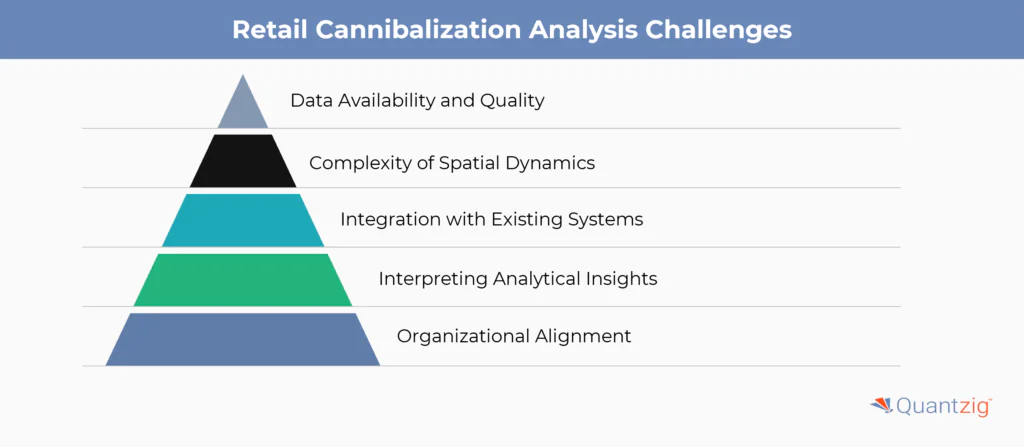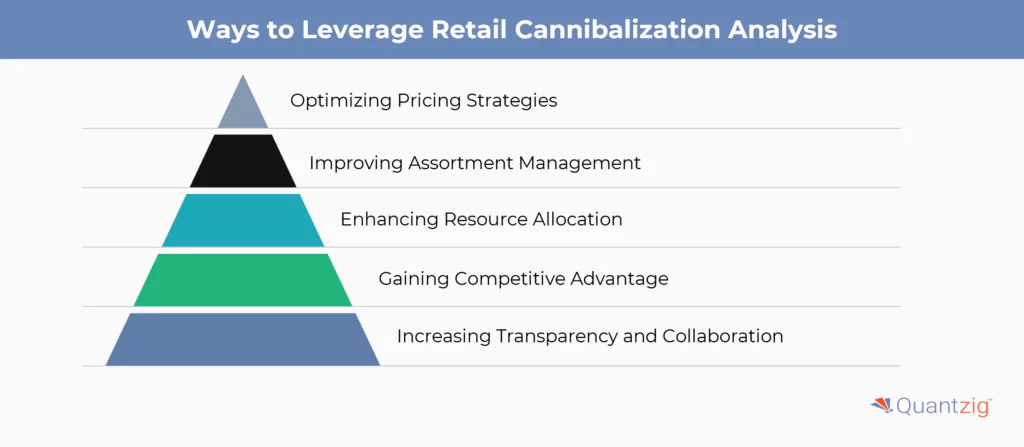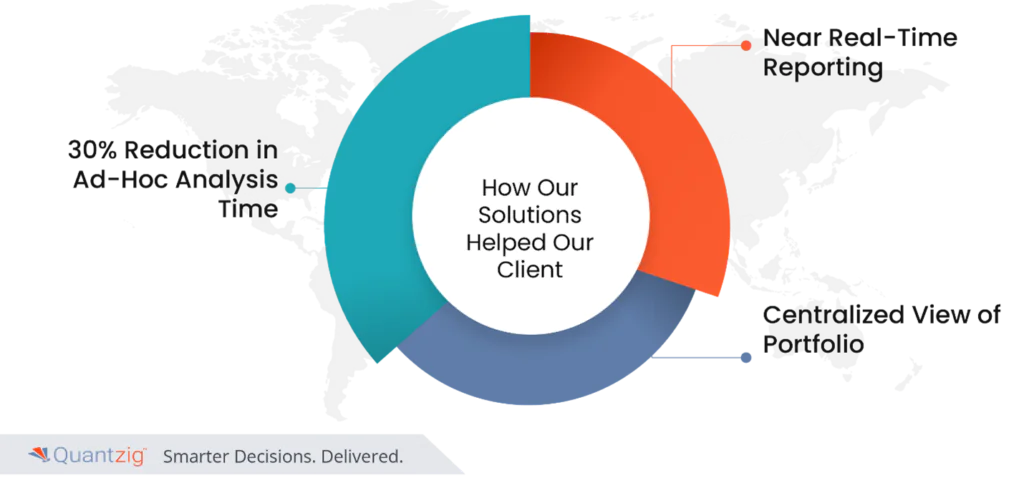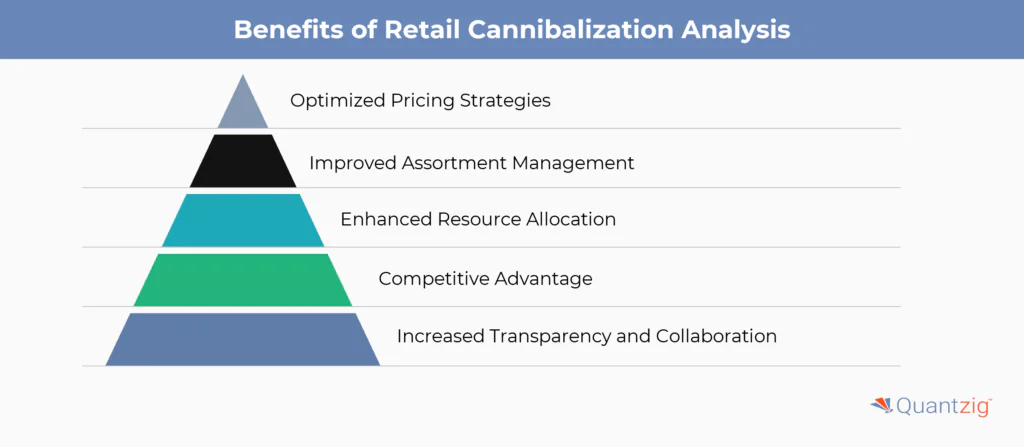Author: Associate Vice President, Analytics and Data Strategy, Quantzig.
Table of Contents
Table of Contents
- Introduction
- What is Cannibalization Analysis?
- A Step-by-Step Guide to Retail Cannibalization Analysis
- Benefits of Retail Cannibalization Analysis
- Challenges in Retail Cannibalization Analysis
- How Can Businesses Leverage Retail Cannibalization Analysis?
- Quantzig’s Expertise in Retail Cannibalization Analysis
- Conclusion
Introduction to Retail Cannibalization Analysis
Are you a business with multiple locations facing challenges in balancing competing demands? Cannibalization analysis can help you navigate these complexities and make informed decisions. Whether you’re a consumer-packaged goods (CPG) company aiming to optimize sales across various points of sale (POS) or a telecommunications firm seeking to maximize ROI from a new 5G tower rollout, understanding the spatial dynamics between different locations is crucial. These organizations must carefully evaluate the impact of new establishments on their existing operations.
This guide provides a comprehensive introduction to cannibalization analysis, walking you through a systematic process from data collection to decision-making. By following these steps, you’ll be equipped with the knowledge and tools necessary to leverage cannibalization analysis effectively in your business.
Book a demo to experience the meaningful insights we derive from data through our analytical tools and platform capabilities. Schedule a demo today!
Request a Free DemoWhat is Cannibalization Analysis?
Cannibalization analysis is a technique used to measure the impact of a new product introduction or pricing change on the sales of an existing product within the same company. It involves analyzing changes in market baskets, average check sizes, and contribution margins to quantify the extent to which the new offering cannibalizes the sales of the original product.
A Step-by-Step Guide to Retail Cannibalization Analysis for Data-Driven Decisions
| Step | Description |
|---|---|
| Step 1: Data Collection | – Collect data on existing locations (current points of sale) – Identify potential new locations that may cause cannibalization – Gather data on factors that could drive cannibalization, such as population, foot traffic, or overlapping catchment areas |
| Step 2: Data Preprocessing | – Establish catchment areas or geographic footprints for each input feature (existing and potential locations) – Incorporate data on factors like urbanity levels to refine the catchment area analysis |
| Step 3: Running Cannibalization Analysis | – Use the Cannibalization Overlap function to calculate two key metrics: 1. Perc_cov_cells: The percentage of the new catchment area that overlaps with the catchment area of an existing location 2. Perc_cov: The percentage of the input variables (e.g., population) that are overlapped between the new and existing locations |
| Step 4: The Decision | – Analyze the cannibalization metrics to understand the potential impact of a new location on existing operations – Use these insights to make informed decisions about market expansion, resource allocation, and optimization of marketing strategies |
This table provides a concise overview of the four main steps in the cannibalization analysis process, as outlined in the search results. The key is to collect the right data, preprocess it to establish meaningful geographic footprints, run the cannibalization analysis, and then use the insights to drive data-driven business decisions.
What are the Benefits of Retail Cannibalization Analysis?
Retail cannibalization analysis offers several key benefits for businesses:
1. Optimized Pricing Strategies
By understanding the impact of new product introductions or pricing changes on existing products, companies can make more informed decisions about pricing to minimize cannibalization and maximize profitability.
2. Improved Assortment Management
Cannibalization analysis helps identify which products within a portfolio are competing with each other, allowing businesses to optimize their product mix and make strategic decisions about which items to promote, substitute or remove.
3. Enhanced Resource Allocation
Insights from cannibalization analysis enable companies to allocate resources more efficiently, directing investments towards high-performing products and locations while scaling back on underperforming ones.
4. Competitive Advantage
Leveraging cannibalization data empowers businesses to stay ahead of the competition by anticipating market shifts and adapting their strategies accordingly.
5. Increased Transparency and Collaboration
A well-designed cannibalization analysis dashboard promotes transparency and facilitates collaboration among cross-functional teams, leading to more informed and aligned decision-making.
Potential Challenges in Retail Cannibalization Analysis

While the benefits of cannibalization analysis are significant, businesses may face several challenges in effectively implementing it:
- Data Availability and Quality: Collecting comprehensive and accurate data on factors like customer behavior, market share, and product performance across channels can be a significant hurdle.
- Complexity of Spatial Dynamics: Accurately mapping the geographic footprint and catchment areas of existing and potential new locations requires advanced spatial analysis capabilities.
- Integration with Existing Systems: Seamlessly integrating cannibalization analysis into a company’s existing technology infrastructure and decision-making processes can be a complex undertaking.
- Interpreting Analytical Insights: Translating the outputs of cannibalization analysis into actionable business strategies requires a deep understanding of the underlying dynamics and their implications.
- Organizational Alignment: Ensuring that cross-functional teams, from marketing to operations, are aligned on the importance and application of cannibalization insights can be a significant change management challenge.
By addressing these challenges and leveraging the benefits of retail cannibalization analysis, businesses can make more informed decisions, optimize their operations, and stay ahead of the competition.
How Can Businesses Leverage Retail Cannibalization Analysis?

1. Optimizing Pricing Strategies
Cannibalization analysis allows businesses to understand the impact of new product introductions or pricing changes on existing products. This enables them to make more informed pricing decisions to minimize cannibalization and maximize profitability.
2. Improving Assortment Management
By identifying which products within a portfolio are competing with each other, cannibalization analysis helps businesses optimize their product mix. They can make strategic decisions about which items to promote, substitute or remove from the assortment.
3. Enhancing Resource Allocation
Insights from cannibalization analysis empower businesses to allocate resources more efficiently. They can direct investments towards high-performing products and locations while scaling back on underperforming ones.
4. Gaining Competitive Advantage
Leveraging cannibalization data allows businesses to stay ahead of the competition by anticipating market shifts and adapting their strategies accordingly.
5. Increasing Transparency and Collaboration
A well-designed cannibalization analysis dashboard promotes transparency and facilitates collaboration among cross-functional teams, leading to more informed and aligned decision-making.
By addressing the challenges of data availability, spatial dynamics, system integration, and organizational alignment, businesses can effectively leverage retail cannibalization analysis to drive data-driven decisions, optimize operations, and gain a competitive edge.
Get started with your complimentary trial today and delve into our platform without any obligations. Explore our wide range of customized, consumption driven analytical solutions services built across the analytical maturity levels.
Start your Free TrialQuantzig’s Expertise in Retail Cannibalization Analysis Solution for a Leading US-based Consumer Goods Manufacturing Company

| Client Information | Challenges faced by the client | Solutions offered by Quantzig | Impact Delivered |
|---|---|---|---|
| Leading consumer goods manufacturing company, headquartered in the USA, with an annual revenue of $1Bn+ | Decision-makers unable to get a comprehensive view of their organization’s performance, leading to: | Designed and implemented a dashboarding solution through cannibalization analysis to track key performance indicators (KPIs) across supply chain and sales operations. | 30% reduction in ad hoc analysis time, near real-time reporting, centralized view of portfolio. |
About the Client
- The client is a leading consumer good manufacturing company, headquartered in the USA with an annual revenue of $1Bn+.
- The company has a strong reputation for producing a wide range of consumer goods in this global competitive marketplace.
- The client has recently launched an oral care product in the global competitive FMCG market, and the commercial team of this company was working on cannibalization analysis to identify the market uptake and stay ahead of the competition.
- The client was looking for a data analytics company that could help them increase transparency and accountability among the stakeholders, get actionable real-time insights into business operations, optimize their supply chain and improve their sales forecasting.
- They found us through a referral form a colleague who has previously worked with us and was impressed with our design thinking approach.
Top Challenges Faced by the Client
The client was facing a number of challenges including:
- Reports from the commercial team were exhaustive and threw a lot of information at the users.
- Reports were static and users had to reach out to the commercial team for scenario-based analysis.
- Insights were mostly standalone and did not provide complete on-ground picture and potential action items. Identifying actions items was very time-consuming.
- Report refresh involved manual effort and took weeks to turn around which impacted timely decision making.
Solutions Offered and Value Delivered
- Implemented an accurate measurement system to quantify the impact of marketing efforts, accounting for the cannibalization effect, leading to a 30% reduction in revenue loss.
- Optimized the supply chain by providing real-time data on inventory levels, production output, and shipping status, enabling the identification of bottlenecks and cost reduction.
- Improved sales forecasting by analyzing historical data and identifying trends, allowing the company to adjust production levels and ensure sufficient inventory.
- Tailored marketing strategies and product offerings to better fulfill customer needs, driven by automated data collection and analysis.
- Developed a well-designed dashboard based on cannibalization analysis, providing real-time access to critical information, improving decision-making, and increasing transparency and collaboration among the business team.
Impact Delivered
30% reduction in ad hoc analysis time, near real-time reporting, centralized view of portfolio.
Experience the advantages firsthand by testing a customized complimentary pilot designed to address your specific requirements. Pilot studies are non-committal in nature.
Request a Free PilotConclusion
Retail cannibalization analysis enabled an FMCG giant to make quick and informed decisions for their newly launched product. By leveraging cannibalization data functions and predictive analytics, the company optimized their product mix and assortment strategy, minimizing product cannibalization. This analysis informed their pricing strategy, ensuring that new sales did not negatively impact existing products. The use of advanced analytics solutions and retail technology improved inventory management, reducing overstocks and maximizing profitability. Ultimately, this strategic approach facilitated swift decision-making, enhancing overall sales performance and market responsiveness for the FMCG giant.





